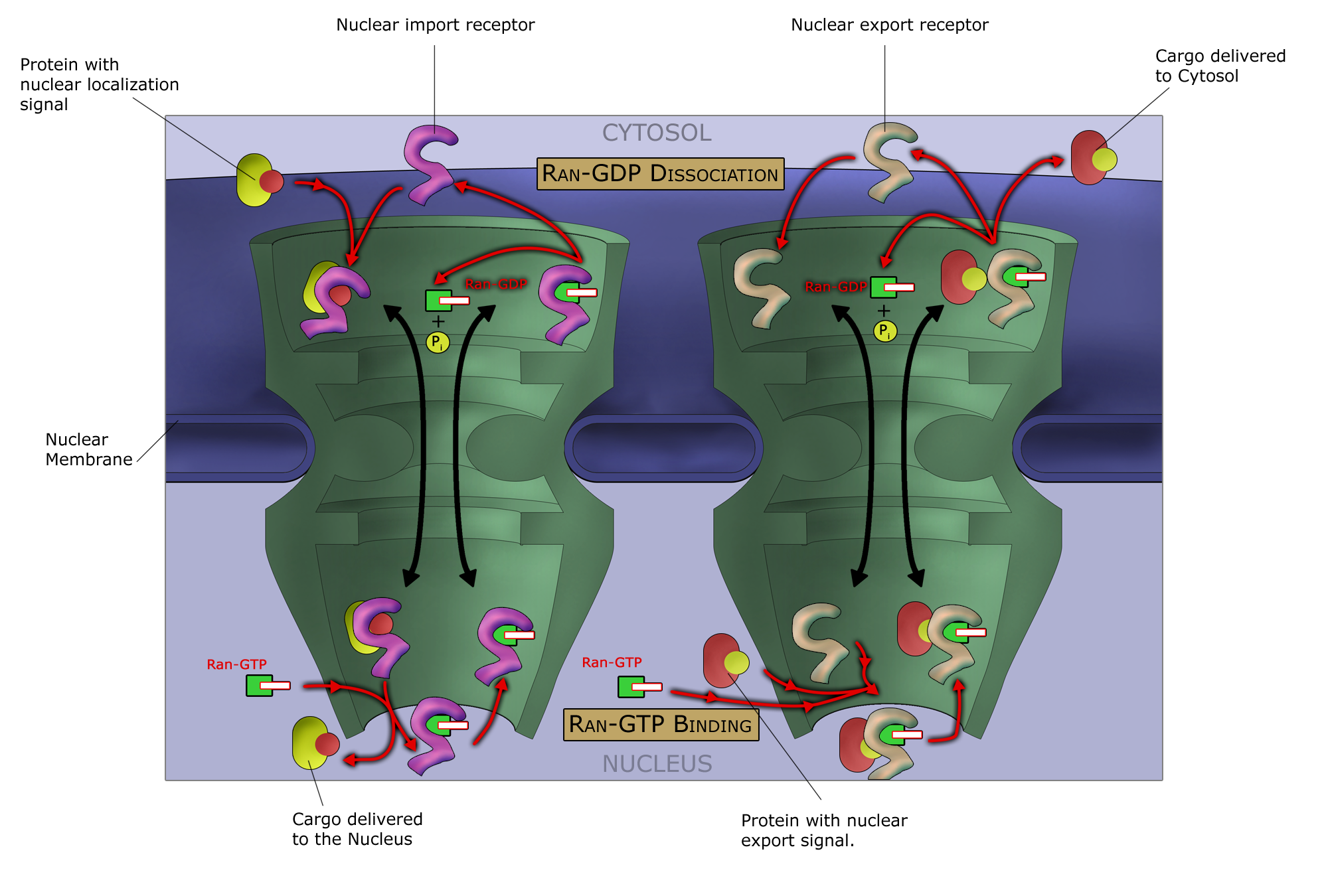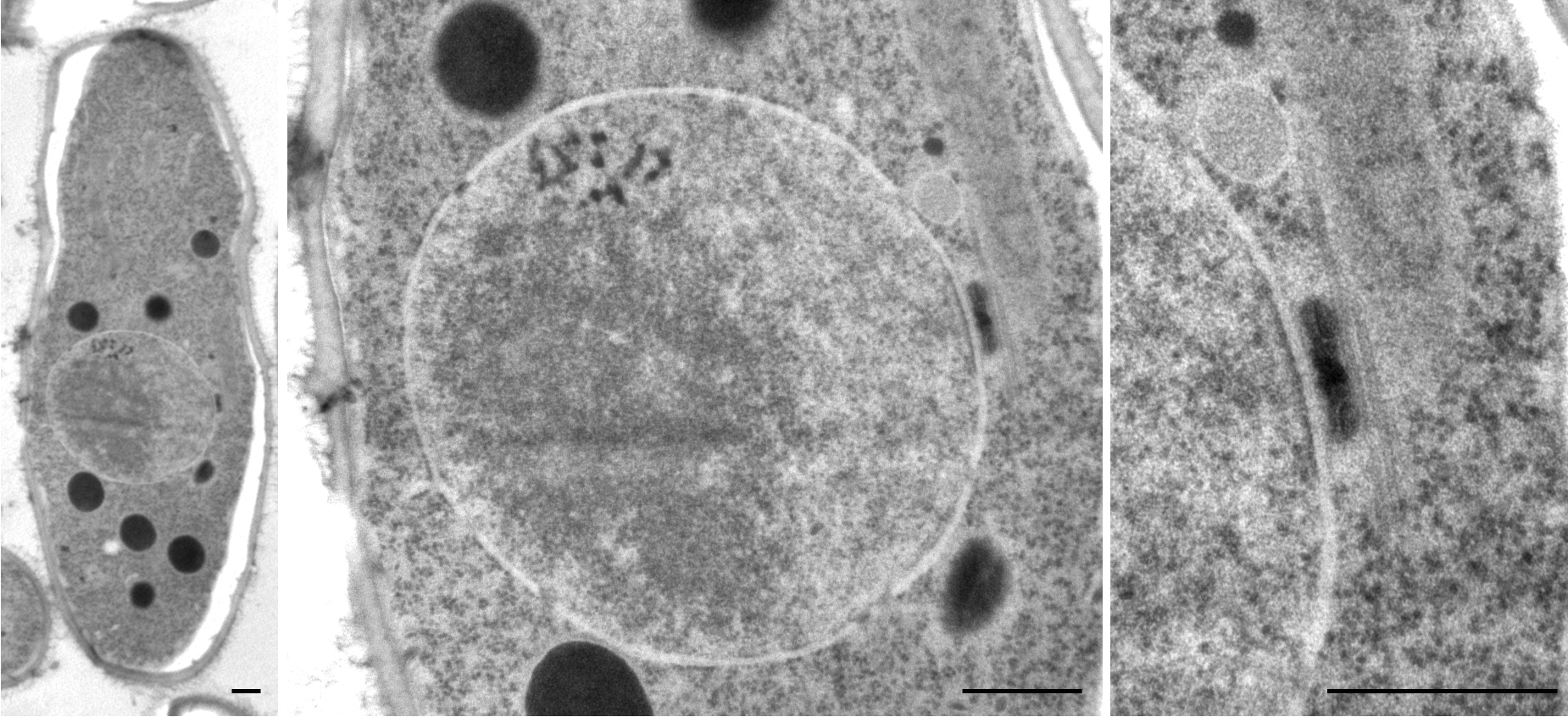|
CRM1
Exportin 1 (XPO1), also known as chromosomal region maintenance 1 (CRM1), is a eukaryotic protein that mediates the nuclear export of various proteins and RNAs. History XPO1 (CRM1) originally was identified in the fission yeast ''Schizosaccharomyces pombe'' in a genetic screen, and investigators determined that it was involved in control of the chromosome structure. It was later shown to be the nuclear transport receptor for cargos with leucine-rich nuclear export signals ( NES). The structural details of the interaction of XPO1 with its cargos were revealed two decades after the gene was identified. Function XPO1 mediates NES-dependent protein transport. It exports several hundreds of different proteins from the nucleus. XPO1 is involved in the nuclear export of ribosomal subunits. XPO1 plays a role in export of various RNAs including U snRNAs, rRNAs (as a part of ribosomal subunits), and some mRNAs. Medical relevance XPO1 is involved in various viral infections. For exa ... [...More Info...] [...Related Items...] OR: [Wikipedia] [Google] [Baidu] |
Nuclear Export Signal
A nuclear export signal (NES) is a short target peptide containing 4 hydrophobic residues in a protein that targets it for export from the cell nucleus to the cytoplasm through the nuclear pore complex using nuclear transport. It has the opposite effect of a nuclear localization signal, which targets a protein located in the cytoplasm for import to the nucleus. The NES is recognized and bound by exportins. NESs serve several vital cellular functions. They assist in regulating the position of proteins within the cell. Through this NESs affect transcription and several other nuclear functions that are essential to proper cell function. The export of many types of RNA from the nucleus is required for proper cellular function. The NES determines what type of pathway the varying types of RNA may use to exit the nucleus and perform their function and the NESs may effect the directionality of molecules exiting the nucleus. Structure Computer analysis of known NESs found the most com ... [...More Info...] [...Related Items...] OR: [Wikipedia] [Google] [Baidu] |
Rev (HIV)
Rev is a transactivating protein that is essential to the regulation of HIV-1 (and other lentivirus, lentiviral) protein expression. A nuclear localization signal is encoded in the ''rev'' gene, which allows the Rev protein to be localized to the Cell nucleus, nucleus, where it is involved in the export of unspliced and incompletely spliced mRNAs. In the absence of Rev, mRNAs of the HIV-1 late (structural) genes are retained in the nucleus, preventing their translation. History A novel protein was found to be involved in the translation of ''gag'' and ''env'' mRNA. The unknown protein functioned by removing repression of regulatory sequences and was named Art (anti-repression transactivator). Later studies suggested that the protein was involved in regulation of the RNA splicing mechanism. Therefore, the name of the protein was modified from Art to Trs (transregulator of splicing). The most recent studies have shown that the protein has multiple functions in the regulation of HIV- ... [...More Info...] [...Related Items...] OR: [Wikipedia] [Google] [Baidu] |
CDKN1B
Cyclin-dependent kinase inhibitor 1B (p27Kip1) is an enzyme inhibitor that in humans is encoded by the CDKN1B gene. It encodes a protein which belongs to the CIP/KIP, ''Cip/Kip'' family of cyclin dependent kinase (Cdk) inhibitor proteins. The encoded protein binds to and prevents the activation of cyclin E-Cyclin-dependent kinase 2, CDK2 or cyclin D-Cyclin-dependent kinase 4, CDK4 complexes, and thus controls the cell cycle progression at G1. It is often referred to as a cell cycle inhibitor protein because its major function is to stop or slow down the cell division cycle. Function The p27Kip1 gene has a DNA sequence similar to other members of the "Cip/Kip" family which include the p21Cip1/Waf1 and p57 (gene), p57Kip2 genes. In addition to this structural similarity the "Cip/Kip" proteins share the functional characteristic of being able to bind several different classes of Cyclin and Cdk molecules. For example, p27Kip1 binds to cyclin D either alone, or when complexed to it ... [...More Info...] [...Related Items...] OR: [Wikipedia] [Google] [Baidu] |
Selinexor
Selinexor sold under the brand name Xpovio among others, is a selective inhibitor of nuclear export used as an anti-cancer medication. It works by blocking the action of exportin 1 and thus blocking the transport of several proteins involved in cancer-cell growth from the cell nucleus to the cytoplasm, which ultimately arrests the cell cycle and leads to apoptosis. It is the first drug with this mechanism of action. The most common side effects include nausea (feeling sick), vomiting, decreased appetite, weight loss, diarrhea, tiredness, thrombocytopenia (low blood-platelet counts), anaemia (low red-blood cell counts), low levels of white blood cells and hyponatraemia (low blood sodium levels). Selinexor was granted accelerated approval by the U.S. Food and Drug Administration (FDA) in July 2019, for use in combination with the corticosteroid dexamethasone for the treatment of adults with relapsed refractory multiple myeloma (RRMM) who have received at least four prior therap ... [...More Info...] [...Related Items...] OR: [Wikipedia] [Google] [Baidu] |
RANBP3
Ran-binding protein 3 is a protein that in humans is encoded by the ''RANBP3'' gene. This gene encodes a protein with a RanBD1 domain that is found in both the nucleus and cytoplasm. This protein plays a role in nuclear export as part of a heteromeric complex. Alternate transcriptional splice variants, encoding different isoforms, have been characterized. Interactions RANBP3 has been shown to interact with RCC1 and XPO1 Exportin 1 (XPO1), also known as chromosomal region maintenance 1 (CRM1), is a eukaryotic protein that mediates the nuclear export of various proteins and RNAs. History XPO1 (CRM1) originally was identified in the fission yeast ''Schizosacchar .... References Further reading * * * * * * * * * * * * * {{Gene-19-stub ... [...More Info...] [...Related Items...] OR: [Wikipedia] [Google] [Baidu] |
Nucleoporin 62
Nuclear pore glycoprotein p62 is a protein complex associated with the nuclear envelope. The p62 protein remains associated with the nuclear pore complex-lamina fraction. p62 is synthesized as a soluble cytoplasmic precursor of 61 kDa followed by modification that involve addition of N-acetylglucosamine residues, followed by association with other complex proteins. In humans it is encoded by the ''NUP62'' gene. The nuclear pore complex is a massive structure that extends across the nuclear envelope, forming a gateway that regulates the flow of macromolecules between the nucleus and the cytoplasm. Nucleoporins are the main components of the nuclear pore complex in eukaryotic cells. The protein encoded by this gene is a member of the FG repeat containing nucleoporins and is localized to the nuclear pore central plug. This protein associates with the importin alpha/beta complex which is involved in the import of proteins containing nuclear localization signals. Multiple transcript ... [...More Info...] [...Related Items...] OR: [Wikipedia] [Google] [Baidu] |
Karyopherin
Karyopherins are protein Proteins are large biomolecules and macromolecules that comprise one or more long chains of amino acid residue (biochemistry), residues. Proteins perform a vast array of functions within organisms, including Enzyme catalysis, catalysing metab ...s involved in transporting molecules between the cytoplasm and the nucleus of a eukaryotic cell. The inside of the nucleus is called the karyoplasm (or nucleoplasm). Generally, karyopherin-mediated transport occurs through nuclear pores which act as a gateway into and out of the nucleus. Most proteins require karyopherins to traverse the nuclear pore. Karyopherins can act as '' importins'' (i.e. helping proteins get into the nucleus) or ''exportins'' (i.e. helping proteins get out of the nucleus). They belong to the nuclear pore complex family in the transporter classification database (TCDB). Energy for transport is derived from the Ran gradient. Upon stress, several karyopherins stop shuttling betwee ... [...More Info...] [...Related Items...] OR: [Wikipedia] [Google] [Baidu] |
SMARCB1
SWI/SNF-related matrix-associated actin-dependent regulator of chromatin subfamily B member 1 is a protein that in humans is encoded by the ''SMARCB1'' gene. Function The protein encoded by this gene is part of a complex that relieves repressive chromatin structures, allowing the transcriptional machinery to access its targets more effectively. The encoded nuclear protein may also bind to and enhance the DNA joining activity of HIV-1 integrase. This gene has been found to be a tumor suppressor and mutations in it have been associated with malignant rhabdoid tumors. Two transcript variants encoding different isoforms have been found for this gene. Interactions SMARCB1 has been shown to interact with: * ARID1A, * BAZ1B, * BRCA1, * CREB-binding protein, * Cyclin-dependent kinase 8, * Myc, * P53, * POLR2A, * PPP1CA, * PPP1CB, * PPP1CC, * PPP1R15A, * SMARCA2, * SMARCA4 Transcription activator BRG1 also known as ATP-dependent chromatin remodeler SM ... [...More Info...] [...Related Items...] OR: [Wikipedia] [Google] [Baidu] |
Ran (biology)
Ran (RAs-related Nuclear protein) also known as GTP-binding nuclear protein Ran is a protein that in humans is encoded by the RAN gene. Ran is a small 25 kDa protein that is involved in transport into and out of the cell nucleus during interphase and also involved in mitosis. It is a member of the Ras superfamily. Ran is a small G protein that is essential for the translocation of RNA and proteins through the nuclear pore complex. The Ran protein has also been implicated in the control of DNA synthesis and cell cycle progression, as mutations in Ran have been found to disrupt DNA synthesis. Function Ran cycle Ran exists in the cell in two nucleotide-bound forms: GDP-bound and GTP-bound. RanGDP is converted into RanGTP through the action of RCC1, the nucleotide exchange factor for Ran. RCC1 is also known as RanGEF (Ran Guanine nucleotide Exchange Factor). Ran's intrinsic GTPase-activity is activated through interaction with Ran GTPase activating protein (RanGAP), fac ... [...More Info...] [...Related Items...] OR: [Wikipedia] [Google] [Baidu] |
RANBP1
Ran-specific binding protein 1 is an enzyme that in humans is encoded by the ''RANBP1'' gene. Ran/TC4-binding protein, RanBP1, interacts specifically with GTP-charged RAN. RANBP1 encodes a 23-kD protein that binds to RAN complexed with GTP but not GDP. RANBP1 does not activate GTPase activity of RAN but does markedly increase GTP hydrolysis by the RanGTPase-activating protein ( RANGAP1). The RANBP1 cDNA encodes a 201-amino acid protein that is 92% similar to its mouse homolog. In both mammalian cells and in yeast, RANBP1 acts as a negative regulator of RCC1 by inhibiting RCC1-stimulated guanine nucleotide release from RAN. Interactions RANBP1 has been shown to interact with XPO1, KPNB1 Importin subunit beta-1 is a protein that in humans is encoded by the ''KPNB1'' gene. Function Nucleocytoplasmic transport, a signal- and energy-dependent process, takes place through nuclear pore complexes embedded in the nuclear envelope. T ... and Ran. References Further reading ... [...More Info...] [...Related Items...] OR: [Wikipedia] [Google] [Baidu] |
Schizosaccharomyces Pombe
''Schizosaccharomyces pombe'', also called "fission yeast", is a species of yeast used in traditional brewing and as a model organism in molecular and cell biology. It is a unicellular eukaryote, whose cells are rod-shaped. Cells typically measure 3 to 4 micrometres in diameter and 7 to 14 micrometres in length. Its genome, which is approximately 14.1 million base pairs, is estimated to contain 4,970 protein-coding genes and at least 450 non-coding RNAs. These cells maintain their shape by growing exclusively through the cell tips and divide by medial fission to produce two daughter cells of equal size, which makes them a powerful tool in cell cycle research. Fission yeast was isolated in 1893 by Paul Lindner from East African millet beer. The species name ''pombe'' is the Swahili word for beer. It was first developed as an experimental model in the 1950s: by Urs Leupold for studying genetics, and by Murdoch Mitchison for studying the cell cycle. Paul Nurse, a fission ... [...More Info...] [...Related Items...] OR: [Wikipedia] [Google] [Baidu] |


